A worldwide group of scientists has proposed archiving what they refer to as the “underwater orchestra” of sea creature sounds, including recordings contributed by both study scientists and willing volunteers. Such an audio archive could aid in the conservation of endangered species, scientific advancement, and the discovery of organisms whose existence is now unknown. Dr. Miles Parsons of the Australian Institute of Marine Science told IFLScience, “We’re not the first to propose this hypothesis.” However, Parsons is the first author of a study published in Frontiers in Ecology and Evolution that provides a much more thorough perspective of how such an archive might work and what it may be used for.
Sound can be a fantastic means to communicate underwater, whether across huge distances, as whales do, or when visibility is limited, as it is in some cases. Even if some of them are outside our hearing range, it is thought that all 126 known marine mammal species use sound similar to this.
Reef fish emit a variety of different clicks. When hunting, penguins produce fast, high-pitched sounds underwater. There are at least a hundred sound-making crustaceans known to marine researchers, such as snapping shrimps, but they are likely certainly just the tip of the iceberg.
It is generally easier to detect the presence of an animal sonically than visually. Parsons told IFLScience that he’s spent a lot of time playing “what’s that sound?” with other fish experts, sharing around underwater recordings in the hopes of figuring out what species are present at a certain spot. Their article claims that instead of hundreds of sound libraries established at specific research institutes, a worldwide platform that everyone could access would function far better. Sound-recognition software could go through a large number of tracks to locate a match for the recordings that are now unknown.
As Parsons points out, we need to have a picture of marine ecosystems in a near-pristine state as quickly as possible. “With biodiversity in decline worldwide and humans continually modifying underwater soundscapes, there is a need to collect, quantify, and understand the sources of underwater animal sounds before they potentially vanish,” according to a statement from Parsons. The establishment of an auditory baseline could also aid in the documentation of habitat changes as species migrate to colder seas. The archive, according to the proposers, can be:
- A reference collection of biological sound sources, both known and unknown
- Annotated and unannotated audio recordings of single sources and soundscapes are stored in this data repository site.
- A platform for artificial intelligence signal detection and categorization algorithms to be trained on.
- An interface for creating sound-based species distribution maps.
- People who enjoy the ocean can engage in this study through a citizen science-based application.
The authors hope that the mere existence of such a resource will motivate more recordings to be made. The archive may aid scientists in identifying biologically rich places that should be protected as a priority. It might also come in handy for comparisons that individual researchers might overlook.
The authors provide the example of the skunk anemonefish, which generates combat noises to frighten off competitors. In Madagascar and Indonesia, however, things are significantly different. Whales are also known to speak in local dialects, and their distinct songs have led to the discovery of new populations. Recognition in unfamiliar places may be aided by familiarity with this diversity.
Identification of noises that scientists are unfamiliar with could lead to global searches, possibly leading to the discovery of species that have yet to be officially identified. One of the goals, according to Parsons, is to raise public awareness of the oceans’ diversity and the threats they confront. “When humpback whale CDs first came out in the 1970s, they had a significant influence,” he remarked, citing how they aided in the abolition of commercial whaling.














